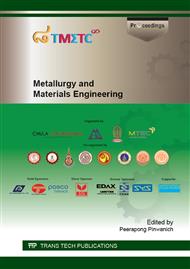p.76
p.81
p.86
p.91
p.96
p.101
p.106
p.111
p.120
An Automatic Selection of Segment Width for the Single Sensor Differential Thermal Analysis (SS-DTA) Based on Piecewise Linear Approximation Technique
Abstract:
Single Sensor Differential Thermal Analysis (SS-DTA) is a novel non-destructive testing technique for studying and detecting the phase transformations and structural changes in materials. It uses only one temperature sensor to measure the temperature in a particular point of interest in the material during actual and simulated thermal processing of the material. SS-DTA compares the temperature recorded in a tested specimen against a reference thermal profile which can be generated either by analytical formulae or piecewise linear approximation. The main advantage of piecewise linear approximation over the analytical formulae is that it does not need the knowledge of tested material and processing conditions to optimally estimate the parameters of reference thermal history. On the other hand, in order to apply the piecewise linear approximation technique we must specify the segment width which is normally fixed at a nominal value of 1.5 seconds. We have recently found that this nominal value might not be an optimal choice for the segment width as it does not guarantee to give the best detectability of phase transformation. Therefore, in this research work we proposed a technique to automatically select an appropriate value of the segment width. The performance of proposed method has been evaluated by investigating the phase transformations of welded stainless steel SUS 321and SUS 304. It was found that the appropriate segment width could be ranging from 1.25-1.75 seconds and by using this selection technique, we could detect the differential temperature more accurately than when using the nominal value.
Info:
Periodical:
Pages:
96-100
Citation:
Online since:
July 2015
Authors:
Price:
Сopyright:
© 2015 Trans Tech Publications Ltd. All Rights Reserved
Share:
Citation:


